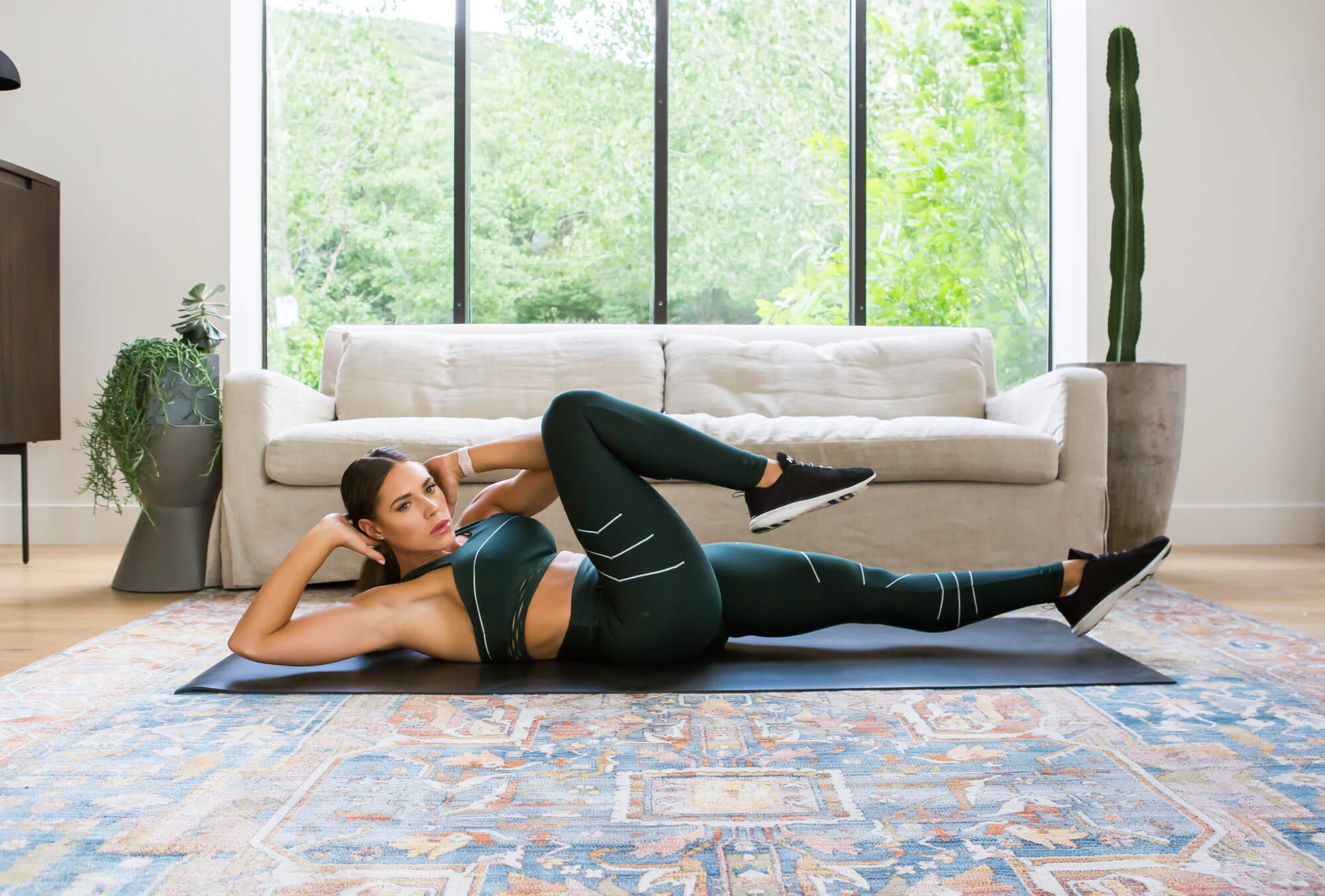8 No-Equipment Exercises


For many women, the barrier holding them back from getting started with strength training or is lack of equipment or space. However, you can start your fitness journey at home — you don’t need anything except yourself and your determination. In fact, I started my own fitness journey at home, and I want to empower you with the tools and knowledge to do the same.
Whether you don’t have access to weights, or you’re nervous about getting started with weighted exercises, you can still reap the benefits of a strength workout that uses your own bodyweight as resistance.
These eight exercises can give you a starting point, and as you gain confidence with exercise and strength you can progress to more difficulty.
What is strength training without weights?
It might seem counterintuitive to do strength training without additional weights (or resistance bands) as resistance. But it is possible. It simply involves using your bodyweight as resistance, instead of equipment, to make movement challenging.
This is known as “bodyweight training” whereby you use gravity as resistance when performing exercises (think classic exercises like push-ups and squats). This is a great way to start your fitness journey or maintain your strength when you don’t have access to equipment.
Can I still increase my strength without weights?
If you are getting started with strength training, you can increase strength without weights — and for those women who usually train with weights, bodyweight training can help you to maintain your progress when you don’t have access to gym equipment.
The benefit of using weights in your workouts is that you can build strength quite rapidly — and when you want to progress and get stronger, all you have to do is increase your weights.
Without weights, this is still possible and achievable. Instead of increasing weights, you can instead increase the number of repetitions of an exercise, or increase the difficulty of the exercise. For example, a push-up on your knees can become a push-up on your toes, before advancing to a decline pushup.
Strength training without weights or equipment is a great place to start if you’re trying to determine which type of exercise is best for you.

Benefits of strength training without equipment
Working out has so many amazing benefits for both your physical and mental wellbeing. But training without equipment has added benefits, too.
Do it wherever you are, whenever you have time
One of the biggest advantages of no-equipment exercises is the convenience of being able to workout anytime, anywhere. This means whether you’re at home, on holiday, or you simply don’t have access to a gym — you can still get a workout in. Working out without equipment also makes it easier to exercise outdoors.
Great for beginners
If you’re new to working out, picking up weights might feel a bit daunting. This is why getting started with zero equipment exercises can allow you to learn correct form and build up your strength, before you move on to weighted movements.
Improves body composition and overall health
A 2012 literature review published in Current Sports Medicine Reports by the Department of Exercise Science at Quincy College found that strength training, which is often referred to as ‘resistance training’, improves overall health and wellbeing, in particular reversing musculoskeletal effects of ageing and reducing lifestyle diseases.
Helps to elevate self-esteem
The same literature review also found that strength training can help to improve self esteem — evidence that supports what I have learned for myself and seen so many women in the PWR Community discover. It’s so true that fitness is not a number — and the benefits are more than just physical.
8 no-equipment exercises to try right now
No-equipment exercises are an effective way to build strength and workout whenever (and wherever) you want. To get started with this workout style, you’ll need to know some basic strength moves you can perform that will deliver results and help you to get fitter and stronger.
Each of these exercises will increase strength and fitness in a different area of your body.
Squat
A basic squat, or air squat, is a squat in its simplest form. Squats increase strength in your quads and glutes primarily, whilst also building muscle in your hamstrings. Air squats are simple, but repeating enough repetitions of them still builds strength, just as weighted squats do.
Squats are a functional movement that can increase mobility in your hips and work almost all of the leg muscles at once.
If you’ve tried squats before and they’ve become too easy, you can make them more difficult even without weights by doing jump squats, or adding variation to the movement with a kneel to squat.
Reverse lunge
Bodyweight reverse lunges are a simple to execute lower-body exercise. They are a great movement to get started with before progressing to more difficult variations of lunges. They primarily build strength in your quads and glutes, as well as your hamstrings.
Lunges differ from squats in that they train each leg once at a time (compared to both at the same time), which means they require a little more balance and stabilisation from your core muscles.
You can increase the intensity of reverse lunges by trying variations — such as a reverse lunge and twist (which requires effort from your obliques) or reverse lunge and knee-ups, which require more exertion from your hip flexor muscles.
Plank
Planks are a great full-body exercise to add your no-equipment workout routine. They primarily target and build strength in the abdominal muscles, while also engaging the shoulders, glutes and quads to keep your body elevated.
Planks are an effective bodyweight exercise for building overall strength, especially core strength. Just like with push-ups, you can start on your knees and progress to your toes as you build strength. Begin by holding the position for 10 seconds and increase to 30 seconds or a full minute as you get stronger over time.
Inchworms
Inchworms are another full-body movement that activates the core, shoulders, arms, and legs. You start by bending over, planting your hands and walking them out from your body.
This movement stretches the hamstrings, and is an effective movement to use in a dynamic warmup.
Sprawl
Sprawls are a slightly more challenging movement to master. This is fast-paced, full-body movement works your shoulders, chest, abdominal muscles and legs, while adding some cardio to a no-equipment strength routine. Using strength building moves like this helps to elevate your heart rate, maintaining the intensity of your workout and helping to make the workout more effective.
Negative Push-up
Negative push-ups build strength in your chest, shoulders and core. Compared to a standard push-up where the effort of the movement is focused on pushing your body away from the ground, in a negative push-up the focus should be on slowly lowering your body to the ground, while maintaining a strong core.
Slowing down the movement challenges your upper body, and your neuromuscular connection, by moving your focus from pushing up to slowly lowering down.
In and Out Plank
In and out planks are a dynamic plank variation. Throughout this movement, you’ll be holding your upper body still in the plank position, while stepping your feet out to the left and right, one at a time.
While this sounds simple, when held for long enough this movement should challenge your core and shoulders.
Squat Pulse
The squat pulse is another variation of the squat. This movement is designed to target your glute muscles, making them fatigued.
This variation of the squat has a much smaller range of motion — this keeps more tension in your glute and quad muscles for a longer time, making it effective for building up strength in these areas (even without weights).
You can experience your own power — no gym equipment necessary
These exercises are found in my PWR Zero Equipment program, a 10-week strength program you can use to begin your fitness journey or maintain strength when you aren’t able to access gym equipment.
I encourage you to make exercise part of your daily routine. You don’t need a lot of time, or even access to gym equipment, in order to begin. You can start by simply making exercise a priority — why not try this Ab Workout from PWR Zero Equipment next?
* Disclaimer: This blog post is not intended to replace the advice of a medical professional. The above information should not be used to diagnose, treat, or prevent any disease or medical condition. Please consult your doctor before making any changes to your diet, sleep methods, daily activity, or fitness routine. Sweat assumes no responsibility for any personal injury or damage sustained by any recommendations, opinions, or advice given in this article.




<#= c.user.username #><#= moment(c.created_at * 1000).fromNow() #>
<#= c.html_body #> <# if (c.images) { #>
<# } #>